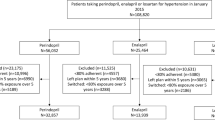Abstract
Objective: To compare the cost effectiveness of the angiotensin II receptor blockers (ARBs) olmesartan medoxomil, losartan, valsartan and irbesartan for the treatment of hypertension, from the perspective of a US managed care setting.
Methods: The evaluation was based on a recently completed, prospective, randomised, double-blind clinical trial comparing the antihypertensive efficacy of these agents. Differences in diastolic blood pressure reductions among the comparative agents were used to estimate reductions in the annualised risk of cardiovascular (CV) and cerebrovascular events using the Framingham model. These annualised risks were translated into reductions in healthcare expenditures associated with treating CV events covered by managed care in the US. Data sources included: the recently published clinical trial of ARB antihypertensive efficacy, the Framingham Heart Study and a managed care database. Actual reimbursed amounts were used.
Results: Based on antihypertensive efficacy data versus irbesartan, the use of olmesartan medoxomil is expected to reduce the number of new cases of CV disease, resulting in a first-year reduction in cost in a cohort of 100 000 patients of $US906 000. Similarly, a reduction in new cases of coronary heart disease (CHD) resulted in a cost reduction of $US701 000; a cost reduction of $US196 000 for fewer myocardial infarctions (MI); and a cost reduction of $US28 000 for fewer strokes. Over 5 years, these estimates increase to $US5 410 000 for fewer cases of CV disease; $US3 975 000 for fewer cases of CHD; $US1 430 000 for fewer MI; and $US497 000 for fewer strokes. Compared with valsartan, the use of olmesartan medoxomil is estimated to reduce by $US3 397 000 the expected cost of treating a cohort of 100 000 patients in the first year for fewer cases of CV disease; by $US2 426 000 for fewer cases of CHD; by $US565 000 for fewer MI; and by $US124 000 for fewer strokes. Over 5 years, these estimates increase to $US16 231 000 for CV disease; $US11 955 000 for CHD; $US4 505 000 for MI; and $1 741 000 for stroke. Compared with losartan, the estimated reduction in first-year cost is $US2 969 000 for CV disease for the cohort of 100 000 patients; $US2 163 000 for CHD; $US732 000 for MI; and $US124 000 for stroke. Over 5 years, these estimates increase to $US15 149 000 for CV disease; $US11 107 000 for CHD; $US4 057 000 for MI; and $1 437 000 for stroke.
Conclusion: Based on comparative antihypertensive efficacy data, treatment of hypertensive patients with olmesartan medoxomil instead of the other leading ARBs has the potential to reduce overall cost of medical care in a US managed care setting.








Similar content being viewed by others
References
Anderson RN, Kochanek KD, Murphy SL. Report of final mortality statistics, 1995. Mon Vital Stat Rep 1997; 45 (11 Suppl. 2): 1–80
Kannel WB. Blood pressure as a cardiovascular risk factor: prevention and treatment. JAMA 1996; 275 (20): 1571–6
Neaton JD, Kuller L, Stamler J, et al. Impact of systolic and diastolic blood pressure on cardiovascular mortality. In: Laragh JH, Brenner BM, editors. Hypertension, pathophysiology, diagnosis, and management. 2nd ed. New York (NY): Raven Press, 1995: 127–44
Cook NR, Cohen J, Hebert PR, et al. Implications of small reductions in diastolic blood pressure for primary prevention. Arch Intern Med 1995; 155 (7): 701–9
Glasziou PP, Mitchell AS. Use of pharmacoeconomic data by regulatory authorities. In: Spilker B. Quality of life and pharmacoeconomic in clinical trials. Philadelphia (PA): Lippincott Raven, 1996: 1145
Hill S, Henry D, Pekarsky B, et al. Economic evaluation of pharmaceuticals: what are reasonable standards for clinical evidence: the Australian experience. Br J Clin Pharmacol 1997; 44 (5): 421–5
Care MoHaL-T. Ontario guidelines for drug submission and evaluation. Ontario: Care MoHaL-T, 2000 Sep
Oparil S, Williams D, Chrysant SG, et al. Comparative efficacy of olmesartan, losartan, valsartan, and irbesartan in the control of essential hypertension. J Clin Hypertens (Greenwich) 2001; 3 (5): 283–91
Physicians desk reference. 56 ed. Montvale (NJ): Medical Economics, 2002
Dawber TR. Epidemiologic approaches to heart disease: the Framingham Study. Am J Public Health 1951; 41: 279–86
Hamilton M, Thompson E, Wisniewski T. The role of blood-pressure control in preventing complications of hypertension. Lancet 1964 Feb 1; I: 238
Collins R, Peto R, MacMahon S, et al. Blood pressure, stroke, and coronary heart disease. Part 2, Short-term reductions in blood pressure: overview of randomised drug trials in their epidemiological context. Lancet 1990; 335 (8693): 827–38
Simons R. Long term compliance with antihypertensive drug therapy in a managed care organization. Edinburgh, Scotland: ISPOR, 1999 Nov 11
Rizzo JA, Simons WR. Variations in compliance among hypertensive patients by drug class: implications for health care costs. Clin Ther 1997; 19 (6): 1446–57
Jonsson B, Johannesson M. Cost benefit of treating hypertension. Clin Exp Hypertens 1999; 21 (5–6): 987–97
Johannesson M, Jonsson B. A review of cost-effectiveness analyses of hypertension treatment. Pharmacoeconomics 1992; 1 (4): 250–64
Anderson KM, Odell PM, Wilson PW, et al. Cardiovascular disease risk profiles. Am Heart J 1991; 121 (1 Pt 2): 293–8
Odell PM, Anderson KM, Kannel WB. New models for predicting cardiovascular events. J Clin Epidemiol 1994; 47 (6): 583–92
Hasford J, Mimran A, Simons WR. A population-based European cohort study of persistence in newly diagnosed hypertensive patients. J Hum Hypertens 2002; 16 (8): 569–75
Acknowledgements
Funding for this study was provided by Sankyo Pharma Inc. The authors have provided no information on conflicts of interest directly relevant to the content of this study.
Author information
Authors and Affiliations
Rights and permissions
About this article
Cite this article
Simons, W.R. Comparative Cost Effectiveness of Angiotensin II Receptor Blockers in a US Managed Care Setting. Pharmacoeconomics 21, 61–74 (2003). https://doi.org/10.2165/00019053-200321010-00005
Published:
Issue Date:
DOI: https://doi.org/10.2165/00019053-200321010-00005




